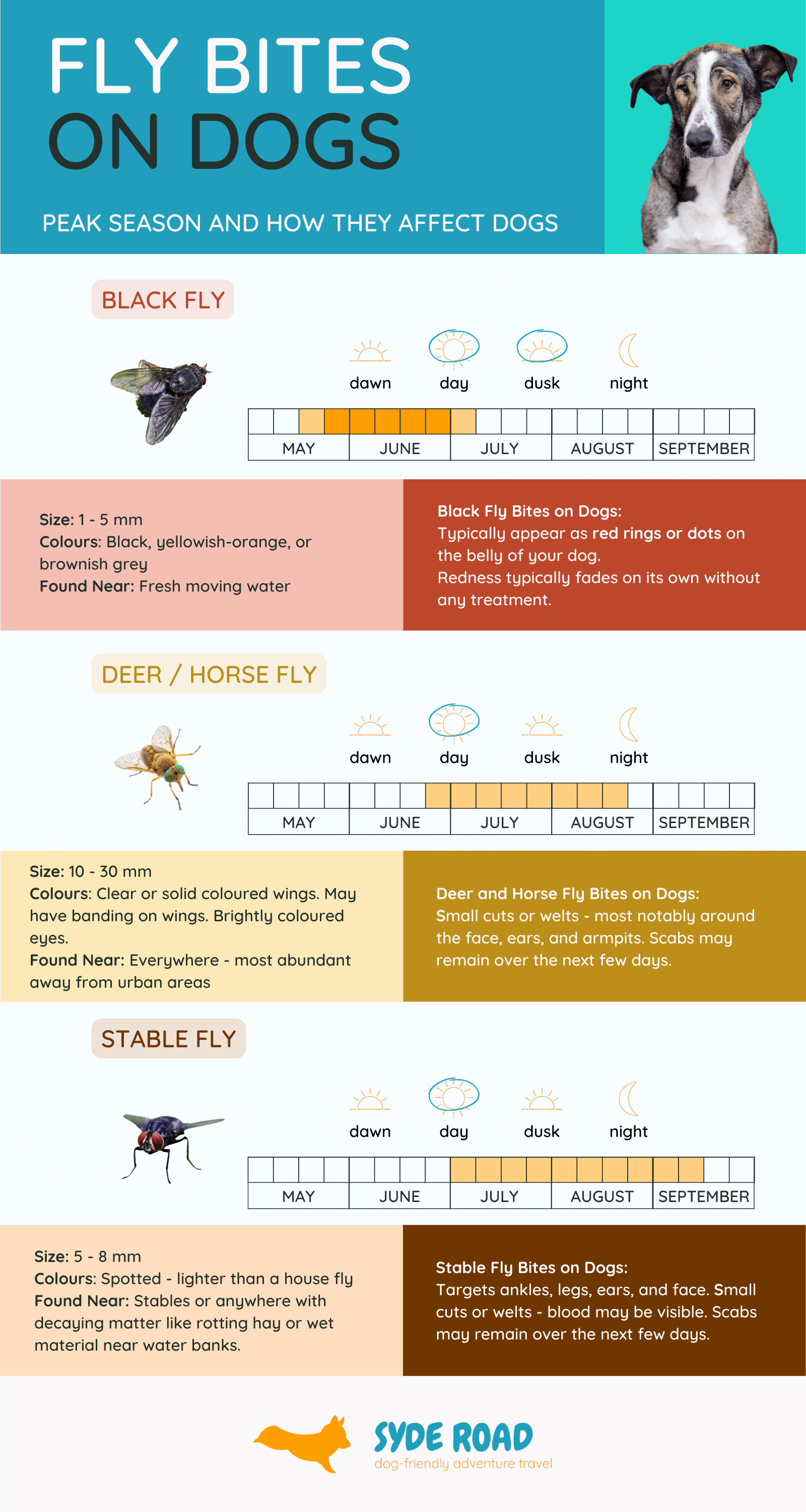How to identify a black fly bite
What to look for: A flat, red splotch that may or may not be outlined. It’s often called a ‘bullseye’ due to the outline, but the entire splotch may sometimes be a completely dark red lump. Black flies tend to bite exposed areas of your pup’s skin like their belly or ears.
Different types of fly bites
Small flies, like yellow flies and no-see-ums, leave a smaller mark. Larger flies, like black and horse flies, primarily buzz around large farm animals and can sometimes draw blood.
Adults are small (1/16 inch), have a stout, dark-colored, rounded back, broad wings, and short legs. They have few hairs on their bodies.
Clusters of small, red bumps (often with halos around them) on your dog’s belly, folds of skin, or paws are often caused by fleas. Small, black pepper-like spots also indicate that fleas are the likely culprit. Your dog may also be licking or scratching a lot and may even have lost some hair or fur in the bite area.
A tick bite will be small and red like the one you might get from a mosquito. It may also be encircled by a red ring. If you think your dog has been bitten by a tick, check to make sure it’s not still on your dog. Removal of the entire tick as soon as possible is imperative.
See our bug bite guide for tips on the treatment of tick bites.
Black flies live around flowing water like streams and rivers. Here they lay eggs and the larvae attach to rocks before emerging as flying adults.
They’re also commonly found on and near farms or in wooded areas and lowlands. If your dog has been near any of these environments, the greater the likelihood the bite that you’re looking at came from a black fly.
They tend to be most active in humid, wooded regions during the summer months. But can be found year-round in semi-tropical regions.
What Do Black Fly Bites Look Like?
Black fly bites have a very distinct look, which makes it easier to identify on your dog. Black fly bites have a red circle or ring around the bite, which resembles a red dot or bullseye. The red bites are sometimes flat and sometimes raised in the center. It can be a bit itchy, depending on the size and the number of bites in general. Black flies often bite softer skin, so you’ll often find bites on your dog’s belly, thighs, and ears.
Except for some mild itching or irritation, black fly bites are harmless and will go away on their own. They look considerably worse than they feel, so there’s no need to panic and rush to an animal hospital. If your dog has a lot of bite marks, keep an eye on them to make sure they don’t develop a bacterial infection.
Which Flies Bite Dogs in Ontario?
In Ontario, the most common flies that bite humans and dogs are:
Here’s an infographic summarizing what each fly looks like, its peak season in Ontario, its peak active time in a day, and where its favourite target areas are on our pooch.

In Ontario, there are 63 different species of black flies (fun fact – there are 1250+ species known worldwide!).
Black flies are small – about 1 – 5 mm and come in varying shades of black, yellowish-orange, and brownish grey. They are mostly found in moving water.
Peak Biting Season: Adults tend to emerge and female black flies actively bite between mid-May to late June. Black flies are most commonly found near seasonal creeks and other freshwater sources like rivers.
Favourite Biting Time: Black flies tend to be most abundant on hot, humid, days.
Black Fly Bites on Dogs: Bites from a black fly typically appear as red rings or dots on the belly of your dog. Your dog isn’t normally bothered by these bites and the redness typically fades on its own without any treatment.
These large flies (10 – 30 mm) are most well known to anyone who has ever ventured outside of urban areas in Ontario.
If you’ve ever been bitten by a fly and it felt like it took a chunk of your skin, then chances are you were bit by these large deer and horse flies.
With their knife-like mouth parts, their bites slash the skin to draw blood. Like the black flies, only the female flies draw blood.
Peak Biting Season: Deer and horse flies are most abundant during the summer months and are most often found around swamps, marshes, or the fringes of woodland areas.
Favourite Biting Time: Most are active during the day. These flies rely on motion to feed.
Deer and Horsefly Bites on Dogs: If deer flies or horseflies swarm your dog, you’ll likely hear them yelp, and see them suddenly twist and snap at the air. These bites hurt! Horsefly bites on your dog can cause small cuts or welts – most notably around the face, ears, and armpits. Some of the cuts may produce visible blood from the bite incisions but will typically clot in a few minutes. Scabs may remain over the next few days.
Closer in size to a house fly (5 – 8 mm), these annoying stable flies tend to go for the ankle and feet. Even worse – both the males and the females will bite for a meal!
Stable flies, much like their name, tend to hang around livestock stables. Their favourite breeding grounds are rotting hay, grasses, or straws – really anywhere with some degree of decaying matter.
Paddlers and swimmers know these are persistent little buggers! Black flies can fly long distances too so chances are you’ll still see them around in the middle of a lake!
Peak Biting Season: Mid to late summer. Stable flies are found near wet, moist, decaying matter.
Favourite Biting Time: Most are active during the day. These flies rely on motion to feed.
Stable Fly Bites on Dogs: While stable flies tend to feed on larger domesticated animals like cattle and horses, these flies will also take the opportunity to feast on your dog too. Stable flies tend to target dog ears. To get a full meal – these flies will bite 4-5 times to get a full meal. Similar to the deer or horse flies, you may notice small cuts and some visible blood. Scabs may remain over the next few days.

Black Fly Bites on Dogs – How Dangerous Are They
Are you thinking of staying in a yurt, glamping, camping, doing a farm stay, or simply heading to a dog beach for the day? Excluding winter camping, the annoying “Bzz! Bzz!” And “Ouch!” of insect bites are inevitable.
When we think of insect bites and harm, we think of protecting dogs from mosquitoes, tick bites, and heartworms.
But there are some insects we tend to forget – biting flies. If you’ve ever kayaked or canoed on a quiet lake or visited a Provincial Park’s dog beach for a day trip, then you’ll know just how painfully annoying biting flies are!
You will find the culmination of all my research on fly bites below. Expand the Table of Contents below to get a quick overview of what you can learn today: Table Of Contents
This post contains affiliate links to products. We may receive a commission for purchases made through some of the links on this post.
Please note that I am not a veterinarian nor am I an animal health care professional. This blog is not intended to be a substitute for professional veterinarian advice, diagnosis, or treatment. Always seek the advice of your veterinarian with any questions you may have regarding the condition and/or the safety of your dog.